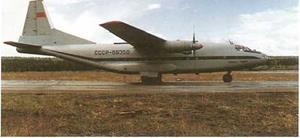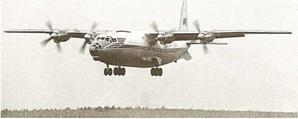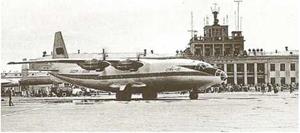A Mainliner from Kiev


The Antonov An-8
Oleg Antonov’s post-war Antonov An-2, whose versatility as a small maid-of-all-work for feeder and bush operations gave it a longevity which keeps it in production even today (pages 42-43), was the harbinger of greater things to come. For in 1956, the Soviet industry sprang another of its surprises and put on display a new military aircraft that had first flown a year earlier.
Though little known, and rarely seen outside its native land, the twin-engined Antonov An-8 deserves recognition as one of the design trend-setters in aircraft construction development history. Its main purpose was to carry troops, military vehicles, and equipment into small unprepared fields for front-line support, and as such, design aspects were directed without compromise to this objective. The An-8’s wing was on top of the fuselage and the landing gear housed in fuselage fairings so that loading through its wide rear ramp/door did not require special ground equipment. The high tail permitted the rear-loading ramp plenty of space for ancillary loading ground equipment. The twin tandem main wheels, four on each side, distributed the load to aid the rough field performance requirements. Antonov perfected the design for specialized freighter aircraft (pages 68-69).
The Ukraina
While the An-8 was strictly a military aircraft (although it appeared in Aeroflot markings), a larger variant, the four – engined, pressurized Antonov An-10, at first called the Ukraina, started to come off the production line in 1959. The general aerodynamic lines were cleaned up, the outer sections of the wing were anhedral — a pronounced feature of later developments of the breed — and behold, a new 90-seat airliner was ready for Aeroflot.
|
|
An-lOA SSSR-11219 displays the definitive configuration with two vertical fins and no endplate tailplane fins. (Courtesy John Stroud)
The military Antonov An-8, progenitor of subsequent all-purpose commercial aircraft with the same basic design criteria. Although Aeroflot never operated An-8s, aircraft appeared with the airline’s titles, (photo: Paul Duffy)
|
|
An-10 SSSR-11158 in original configuration with single vertical fin and endplate fins on the tailplane. (Courtesy John Stroud)
Consolidation of Domestic Routes
As noted on the page opposite, the developed Antonov 10A, the most successful of the basic type, was quickly brought into service, on 10 February 1960, on the routes from Moscow and Leningrad to the south. Production of modern aircraft was now in full swing at the Antonov, Ilyushin, and Tupolev factories and assembly plants scattered throughout the U. S.S. R., and Aeroflot seemed to have come of age at last. The fleet strength at this time was reported to be 1,900 aircraft, of which about 120 were Tupolev Tu-104s, 60 Ilyushin Il-18s, 30 Antonov An-lOs. A Tu-104 flew to Toronto for an aviation Expo on 6 September 1959, and an An-10 flew to the U. S.A. on 24 December. The 11-18 began service to London, and in April 1960 started non-stop flights to Cairo. The Moscow-Leningrad intercity service was upgraded to a frequency of 15 daily flight on 1 June 1960, and Aeroflot was now carrying more than 20 million passengers a year.
Aeroflot to the Arctic
Coinciding with this widespread traffic upsurge, Aeroflot expanded its route network. On 3 February 1960, all the operations of Polar Aviation (see pages 26-27) were transferred to the state airline. An-lOs were deployed to the northern wastelands, cargo flights starting on 5 April 1960. Then in August, an An-10 had the honor of pioneering the great circle route from Moscow to Khabarovsk, via Syktyvkar, Noril’sk), and Yakutsk. By June 1961, it had become the standard aircraft for the polar air routes, replacing the Lisunov Li-2 and the Ilyushin 11-14.
|
|












